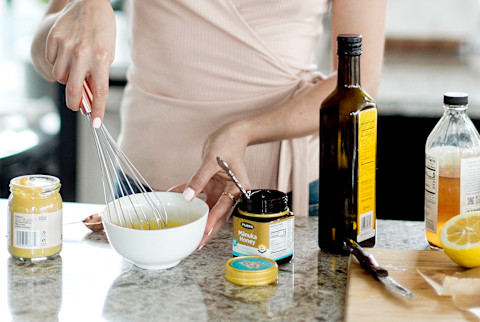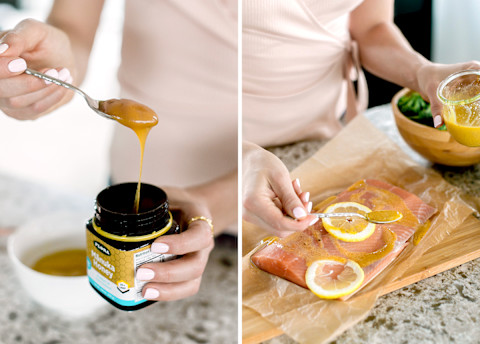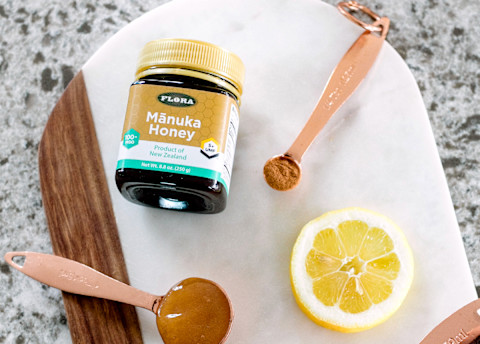I’m an RD—Here’s How I Use Up An Entire Jar of Manuka Honey

Honey. It's a term of endearment for the ones we love, and it always came in a bear-shaped bottle your mom would let you squeeze into tea when you had a scratchy throat as a child. But fast-forward to now, and you've probably heard of another type of honey called Manuka honey. Manuka honey is getting lots of buzz—not just from the bees—in the health and nutrition world because of its impressive benefits.
Manuka honey is honey derived from bees that feed on the Manuka plant found in New Zealand. It's rich in a natural compound called Methylglyoxal (or MGO), which is also found in other types of honey but in quantities too low to have antibacterial properties.
Generally, honey has been used for hundreds of years to treat health conditions, though the benefits and quality depend on the kind of honey being used. Each jar of genuine Manuka honey contains a number that signifies the strength of its compounds' activity levels known as the Unique Manuka Factor™ (UMF™), which is a third-party grading system established just for this type of honey.
Some labels might say 'Manuka' even when the honey inside is missing the enzymes and antioxidant properties of true Manuka.
As a dietitian, I strongly recommend reading ingredient labels, and it's especially important when it comes to choosing a type of Manuka honey. Some labels might say "Manuka" even when the honey inside is missing the enzymes and antioxidant properties of true Manuka honey. I opt for Flora's Manuka Honey because it's UMF™-certified (Unique Manuka Factor™), which ensures third-party testing for the unique properties that are exclusive to Manuka honey.

Flora Manuka Honey also provides an NFC tag on the label that allows you to see where your jar of honey was made just by scanning it with your smartphone. I love that because I believe the more we know about our food and where it comes from, the greater opportunity we have to make nutrition choices that affect our families and the environment in the best way possible.
My 5 go-to Manuka uses.
This jar of Manuka honey is a pantry staple of mine that I'm finding new ways to use every time I create a new recipe or home remedy. It's so versatile, and I like the boost of added health benefits that come with it.

You can use Manuka honey similarly to how you would use regular honey. However, keep in mind that Manuka honey is thicker and spreadable compared to regular honey, which is liquid at room temperature.
Here's how I take advantage of its unique texture and benefits:
- In a honey-yogurt glaze over baked salmon. I love using Manuka honey for supporting my gut health. Paired with Greek or Icelandic-style yogurt that is rich in probiotics—the good bacteria your gut needs—it's a delicious way to get a dose of gut-boosting benefits.
- In a honey mustard dressing or dipping sauce. Many honey mustard dressings contain partially hydrogenated oils and other preservatives. A healthy homemade version with Manuka honey allows me to use whole food ingredients and is the perfect texture for dressings and sauces.
- In a DIY pumpkin honey face mask. Manuka honey is a great choice for the skin because it helps retain moisture and works to pull moisture into the skin. Pumpkin is high in vitamin C, a precursor to collagen, so using the two together in a mask will help to brighten and keep the skin hydrated.
- Straight off the spoon during the cold months to help ease a scratchy throat. Reach for a spoonful of Manuka honey at the first signs of a sore throat—it's a quick way to help soothe it.
- Oven-roasted vegetables. Instead of roasting winter veggies in refined sugar for sweetness, add a tablespoon of Manuka honey after they are roasted to bring out the flavors. I find it works especially well with hearty winter vegetables like butternut squash, Brussels sprouts, and carrots. Just don't roast vegetables with Manuka honey because high heat can inhibit its natural benefits.
These are the go-to ways that always empty my jar faster than I realize, not to mention I'm constantly trying out new uses. Thankfully, a brand-new jar is never too far behind.
The information in this article is the opinion of the author and/or individuals quoted and in no way reflects the policies or positions of Flora Health. This is not intended to be a substitute for professional medical or nutrition advice.
